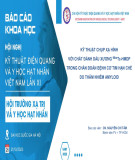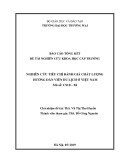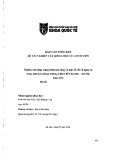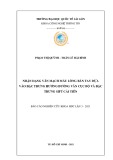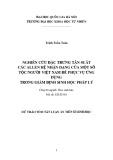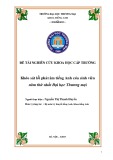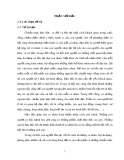
RESEARC H ARTIC LE Open Access
Profile of subjective quality of life and its correlates
in a nation-wide sample of high school students in
an Arab setting using the WHOQOL-Bref
Ghenaim A Al-Fayez
1
and Jude U Ohaeri
2*
Abstract
Background: The upsurge of interest in the quality of life (QOL) of children is in line with the 1989 Convention on
the Rights of the Child, which stressed the child’s right to adequate circumstances for physical, mental, and social
development. The study’s objectives were to: (i) highlight how satisfied Kuwaiti high school students were with life
circumstances as in the WHOQOL-Bref; (ii) assess the prevalence of at risk status for impaired QOL and establish the
QOL domain normative values; and (iii) examine the relationship of QOL with personal, parental, and socio-
environmental factors.
Method: A nation-wide sample of students in senior classes in government high schools (N = 4467, 48.6% boys;
aged 14-23 years) completed questionnaires that included the WHOQOL-Bref.
Results: Using Cummins’norm of 70% - 80%, we found that, as a group, they barely achieved the well-being
threshold score for physical health (70%), social relations (72.8%), environment (70.8%) and general facet (70.2%),
but not for psychological health (61.9%). These scores were lower than those reported from other countries. Using
the recommended cut-off of <1SD of population mean, the prevalence of at risk status for impaired QOL was
12.9% - 18.8% (population age-adjusted: 15.9% - 21.1%). In all domains, boys had significantly higher QOL than
girls, mediated by anxiety/depression; while the younger ones had significantly higher QOL (p< 0.001), mediated
by difficulty with studies and social relations. Although poorer QOL was significantly associated with parental
divorce and father’s low socio-economic status, the most important predictors of poorer QOL were perception of
poor emotional relationship between the parents, poor self-esteem and difficulty with studies.
Conclusion: Poorer QOL seemed to reflect a circumstance of social disadvantage and poor psychosocial well-being
in which girls fared worse than boys. The findings indicate that programs that address parental harmony and school
programs that promote study-friendly atmospheres could help to improve psychosocial well-being. The application
of QOL as a school population health measure may facilitate risk assessment and the tracking of health status.
Keywords: Quality of life students, Arab, gender, age, parents
Background
The upsurge of interest in the quality of life (QOL) of
children in general population samples is in line with
the 1989 Convention on the Rights of the Child, which
stressed the child’s right to adequate circumstances of
physical, mental, and social development [1,2]. While
most of the general population studies have emanated
from the western world [3-11], a few have come from
Asia [12-14], South America [15] and Iran [16]. There
are no such reports from the Arab world. The lone
report on QOL for students from an Arab country was
based on a convenience sample of 224 college students
and was focused on the relationship with intensity of
religiosity [17].
Although various authors have recommended that the
assessment of QOL among adolescents should include
contextual variables that are not generally regarded as
health-related (e.g., satisfaction with family and peer
* Correspondence: judeohaeri@hotmail.com
2
Department of Psychiatry, Psychological Medicine Hospital, Gamal Abdul
Naser Road, P.O. Box 4081, Safat, Kuwait
Full list of author information is available at the end of the article
Al-Fayez and Ohaeri BMC Psychiatry 2011, 11:71
http://www.biomedcentral.com/1471-244X/11/71
© 2011 Al-Fayez and Ohaeri; licensee BioMed Central Ltd. This is an Open Access article distributed under the terms of the Creative
Commons Attribution License (http://creativecommons.org/licenses/by/2.0), which permits unrestricted use, distribution, and
reproduction in any medium, provided the original work is properly cited.

relationships and family income) [5,18-23], most
reports have been based on health-related quality of
life (HRQOL) measures [reviewed, [1,24]]. Only a few
have used instruments that attempt to cover the
broader issues of QOL [7,11,13], including a modifica-
tion of the WHO Quality of Life Instrument (WHO-
QOLI) [13,25]. QOL measures that focus on the
construct of HRQOL have been criticized on the
grounds that their narrow focus on the impact of
health conditions on physical, psychological and social
functioning implies that full health equates to maxi-
mum QOL [24,26-29]. In a critique of six definitions
of QOL, it was suggested that defining QOL in terms
of life satisfaction is the most appropriate [29]. Instru-
ments for pediatric QOL assessment should have con-
ceptually strong underpinnings[24].
It is important to assess the QOL of adolescents and
young adults of school age using instruments that
include contextual variables, because the vast majority
are healthy [30]; and since QOL is sensitive to distress
in various domains of living [31], the data can help to
provide information beyond symptoms, to identify an
otherwise undetectable high risk group for problems
[32]. For such a population, reliance on the traditional
measures of health could lead to under-identification
of psychosocial problems, “the new hidden morbidity”
[5,33]. In view of the above considerations, we have
used the short version of the WHOQOLI (the WHO-
QOL-Bref) to assess the subjective QOL of a nation -
wide sample of senior high school students; first,
because the items emphasize satisfaction with life cir-
cumstances [24,29], andthedomainsencompass
health-related and contextual issues that have been
found to be important for adolescents [19,34]. Second,
the Arabic translation of the WHOQOL-Bref has been
shown to have satisfactory reliability and validity
indices in general population and clinical samples
[35,36]. Third, the WHOQOL-Bref was simultaneously
developed in diverse cultures, thus overcoming the
usual controversy over the problem of applying a ques-
tionnaire articulated in one culture in a different cul-
ture [25,37]. It is noteworthy that the original
validation sample for the WHOQOL-Bref [25] included
adolescents (aged 12 - 19 yrs). In other words, the
WHOQOL-Bref is judged to be appropriate for the age
groupthatwestudied.Wehavedonetheassessment
usingthemodeldescribedbyJirojanakuletal[13].In
this model, personal and parental background factors,
general health factors and socio-environment factors
are all significantly associated with QOL.
This is based on the evidence that personal background
factors have been found to be associated with QOL. Thus,
while reports of adolescent samples (>12 years) consis-
tently found that poorer QOL was significantly associated
with female gender and older age [3,5,16,38-41], the
reports that involved children who were less than 12 years
of age either found that there were no significant gender
differences [42], or that the girls had significantly better
QOL [13,14,43]. In addition, poorer QOL was associated
with poor physical health, psychic distress, and low self-
esteem [7-9]. Of the parental factors, the consistent find-
ings are that, poorer QOL was associated with parental
low socio-economic status, low educational attainment,
and divorce [3-5,7-10,15,44,45]. Of the socio-environmen-
tal factors, parental stress and the quality of emotional
relationship between the parents were found to have long-
term implications for the child’s well-being [6,9,46,47].
Interestingly, children can reliably report on the quality of
emotional relationship between their parents, while par-
ents can predict children’s response about parental rela-
tionship [46,48]. Furthermore, better QOL was
significantly associated with easy access to health service,
lack of feeling of difficulty at school, and connectedness
with school [5,8,49]. It has been suggested that older ado-
lescents tend to have poorer QOL, possibly because they
are exposed to greater social demands and stresses, such
as increased academic, emotional and other social pres-
sures, so that they tend to have relatively more difficult life
situations to contend with, in comparison with the
younger ones [19].
At the conceptual level, a notable problem with QOL
data is the interpretation of what the data mean. This
problem concerns the issues of a cut-off score for poorer
QOL or the identification of subjects “at risk status for
impaired QOL”[30], and the clinical significance of the
scores [50,51]. An important helpful step in this regard is
the use of scales whose domains are aggregated into per-
centage maximum score of 0 to 100 (i.e., % scale maxi-
mum or % SM method). In a review of several studies
from the western world, it was found that the average
score for healthy populations tended to be in the range of
70 - 80% SM [22,52]. Accordingly, it was suggested that
subjective well-being could be operating within a psycho-
logical homeostatic regulation system (like body tem-
perature) that is represented by a score of 70%-80% of
scale maximum for QOL instruments [22]. It appears
that this recommendation is relevant for pediatric popu-
lations, too. For example, in a review of the Pediatric
Quality of Life (PedsQOL) [4] domain scores of six stu-
dies in large samples of school children from the western
world, it was shown that in five of them, the average
scores for the domains of QOL (using child ratings) ran-
ged from 72.9% to 91.1% [9]. In the sixth study, the chil-
dren had a mean total PedsQOL score of 67.2, which the
authors considered to be relatively low [8]. Other studies
from Finland (75.4% - 85.0%) [38] and the USA (78.2% -
84.0%) [30] had similar findings. This is supported by
similar data from non-western countries, such as Korea
Al-Fayez and Ohaeri BMC Psychiatry 2011, 11:71
http://www.biomedcentral.com/1471-244X/11/71
Page 2 of 12

(82.6% - 93.5%) [12], Brazil (73.0% - 93.1%) [15], and Iran
(71.7% - 90.9%) [16]. For another questionnaire, the Gen-
eric Children’s Quality of Life Measure, a UK study
reported 72.7% - 75.3% [11]. Using another yardstick, it
has been suggested that a QOL domain score of 1 stan-
dard deviation (1SD) below the population mean would
probably help to identify subjects at risk for impaired
QOL [9,30,53], because such scores represent scale
scores similar to those of children with severe chronic
health conditions [30].
Thedesignofourstudywasguidedbytheissues
highlighted above. With regard to those issues, the
Kuwaiti perspective is important because it adds the
contribution from a country where, for nationals, there
is an effective national social welfare system, health care
services are free and easily accessible; and the conserva-
tive Muslim culture, with traditional gender roles and
sexual segregation, prevails. It has been suggested that
QOL is context-specific [13].
Objectives
The specific objectives of the study were to:
(i) highlight how satisfied Kuwaiti senior high school stu-
dents were with life circumstances as in the WHOQOL-
Bref; (ii) estimate the prevalence of at risk status for
impaired QOL, and establish the QOL domain score nor-
mative values, in comparison with the international data
[25]; (iii) examine the relationship of QOL with personal
factors (socio-demographic variables), general health factors
(subjects’perception of being currently ill, and their scores
on scales for anxiety, depression and self-esteem); parental
factors (parental employment, educational and marital sta-
tus); and socio-environment factors (perceived difficulty
with studies and social relationships, and perceived quality
of emotional relationship between the parents).
We hypothesized that, in view of the widely noted
importance of parental material well-being and health
access:
- Kuwaiti students would be generally satisfied with
their circumstances of living,
- and their average QOL domain scores would be
high, in comparison with the international data.
- In view of the robust findings in the literature, how-
ever, poorer QOL would be significantly associated
with female gender, older age, high scores on anxiety
and depression, low self-esteem and poor perception
of the emotional relationship between the parents.
Methods
Participants and setting
Kuwait is an oil - rich Arab country, located in the Ara-
bian Gulf. Of the total 3.4 million population, Kuwaiti
nationals make up about 1.1 million (48.9% male, 51.1%
female) (2007 census). There are six administrative dis-
tricts or governorates. About 97% live in urban areas,
and the unemployment rate is 2.3% (2004 estimate).
According to the 2007 census data from the Kuwait
Public Authority for Civil Information (PACI), those
aged 14 - 23 years (our sample age range) (212144) con-
stituted 20.4% of nationals (50.5% male, 49.5% female).
Our sample size was guided by the recommendation of
the International Quality of Life Assessment (IQOLA)
project researchers, that the sample size for general
population norming should be 2500 - 3000 [54]. This
would allow for comparison of scale scores by gender
and 10 - year age groups.
The study took place in Kuwaiti government second-
ary schools in all the governorates. All such schools are
sexually segregated. Accordingly, the sampling strategy
was aimed at representing the three types of schools,
viz: boys’, girls’, and the credit-hour system (i.e., senior
high schools where students have the option to choose
three subjects per session). The focus was on students
in the senior classes, consisting of grades (class years)
10, 11, and 12. This is because the questionnaires are
self - rated and there was need to focus on an age
group that would not have difficulty understanding and
completing them. In 2006/7, a nationwide sample of
4467 senior high school students (mean age 16.9, SD =
1.2 yrs, range = 14 - 23) in Kuwaiti government second-
ary schools was studied, with adequate representation of
the governorates and gender (48.6% boys). The partici-
pants hailed predominantly from fairly large, stable and
harmonious family homes (83.1% rated parental rela-
tionship as good/excellent; 85.1% of parents lived
together, and average sibling size was 6.3). Most fathers
(73.3%) were gainfully employed. Of the 4442 (99.4%)
who stated their nationality, 3771 (87.3%) were Kuwaitis,
69 (1.6%) were stateless citizens ("bedoons”), and 458
(10.3%) were from other Arab countries, especially the
Arabian Gulf states.
Procedure
First, a list of all the government secondary schools was
obtained from the Ministry of Education. Six schools
were randomly selected from each of the six governor-
ates (total, 36 schools), viz: two each from boys’, girls’
and credit-hour system. From each selected school, two
classes each from grades 10 and 11, and one class from
grade 12 were randomly selected, in order to proportio-
nately represent the number of classes in each grade.
Ethical considerations
The study was carried out in compliance with the Helsinki
Declaration. Hence, the protocol for all aspects of the
study, including the pilot testing of the questionnaires, was
Al-Fayez and Ohaeri BMC Psychiatry 2011, 11:71
http://www.biomedcentral.com/1471-244X/11/71
Page 3 of 12

approved by the institutional review boards of the Kuwait
Ministry of Education and the Kuwait Society for the
Advancement of Arab Children (KSAAC). Thereafter, the
Principal of each selected school was approached for
approval and for the cooperation of the school’s psycholo-
gists. At the preliminary stage of the study, the research
team hosted the psychologists of the selected schools at
meetings facilitated by the Ministry of Education.
A few days after explaining the objectives of the study
to the selected classes, the schools’psychologists and
class prefects chose dates and times convenient to the
study schedule. In the few days between explaining the
nature of the study and the completion of the question-
naires, the students were requested to inform their par-
ents about the study, in case any parents would refuse.
It was emphasized that refusal to participate would not
lead to any form of punishment. In the Kuwaiti culture,
this method of obtaining informed consent from the
Ministry of Education, the KSAAC, and the school prin-
cipals, is deemed sufficiently ethical for such a study.
Moreover, the questionnaires were completed in class,
under the supervision of school psychologists whom the
students and their parents were familiar with. There
were no refusals by parents and students. In order to
ensure adequate supervision and explain possibly diffi-
cult items, the school psychologists stayed with them in
class while the students completed the questionnaires,
anonymously. All students in the selected classes agreed
to complete the questionnaires. Although we did not
record the number of students who were not present in
school for the selected classes on the days of the study,
our impression was that this number was probably very
small and not obvious to the school psychologists.
Pilot testing of the questionnaires
Before the commencement of the study, the question-
naires were translated into Arabic by the method of
back - translation. The research team critically examined
the instruments and presented them to senior mental
health workers to examine the face validity of the con-
tents. Thereafter, the modified version, as detailed
below, was pilot tested among students (50 boys and 50
girls), from two schools that were not part of the main
study, using the same methodology as described above.
Test - retest reliability was assessed by analyzing the
responses of 55 subjects (from the 100) who volunteered
to complete the final questionnaires twice in a four -
week period.
Operational definitions
We accepted the WHO definition of QOL as indivi-
duals’perception of life in the context of the culture
and value system in which they live and in relation to
their goals, expectations, standards and concerns [25].
This was the conceptual framework for articulating the
WHOQOL Instrument [34]. It has also been adopted as
the conceptual framework for a measure of QOL for
children [55]. Our focus was on subjective QOL, as dis-
tinct from objective QOL [56].
We defined subjects’satisfaction as the level of posi-
tive appreciation for each item of the WHOQOL-Bref
[29]. That is, we used the idea of satisfaction for an item
as a rating of more than average or neutral point
[57,58], which in the case of the WHOQOL-Bref varies
(according to the wording of the item) as: good/very
good; mostly/completely; or satisfied/very satisfied.
Hence, we quantified the group’s satisfaction with each
item as at least 50% of respondents in the group rating
the item as good/very good; dissatisfaction (< 50%); bare
satisfaction (50 - 65%); moderate satisfaction (66 - 74%);
and highest satisfaction (≥75%) [56].
The WHOQOL - Bref
This is a 26 - item self - administered generic question-
naire, being a short version of the WHOQOL - 100 scale
[25]. The response options range from1 (very dissatis-
fied/very poor) to 5 (very satisfied/very good). It empha-
sizes the subjective responses rather than objective life
conditions, with assessment made over the preceding two
weeks. It consists of domains (or dimensions) and a facet
(or sub - domain). The items on “overall rating of QOL”
(OQOL) and subjective satisfaction with health, are not
included in the domains, but are used to constitute the
general facet on OQOL and general health (general
facet). The more popular model for interpreting the
scores has four domains, namely, physical health (seven
items), psychological health (six items), social relations
(three items) and environment (eight items). Our analysis
was based on this model.
The domain scores of the WHOQOL-Bref can be
computed in three ways. The first is a summation of the
raw scores of the constituent items. The second and
third ways consist of transforming the raw scores. In the
second way, the raw scores are transformed into scores
that range from 4-20, to be in line with the WHOQL
-100 Instrument. The third way, which is the percentage
scale maximum (% SM) is a standardized conversion of
Likert scale data projected onto a 0-100 scale. The
WHOQOL Group has provided guidelines for these
conversions [59]. The value of the later transformed
score method (i.e., % SM) is that it can be used for mak-
ing comparison with other scales [52].
There was need to modify the framing of some items of
the WHOQOL-Bref in order to make them suitable to
the circumstances of school age persons in this culture.
First, the WHOQOL has no item on “school”.Second,
high school students in this culture are entirely depen-
dent on their parents for financial and transportation
Al-Fayez and Ohaeri BMC Psychiatry 2011, 11:71
http://www.biomedcentral.com/1471-244X/11/71
Page 4 of 12

needs. Third, by law, they are prohibited from engaging
in romantic sexual activities. Accordingly, following the
methods in the literature [1,23], we modified the follow-
ing items of the WHOQOL-Bref to read thus:
(a) Item 12, on money: “How satisfied are you with
the money available in your family for your care"; (b)
Item 18: “How satisfied are you with your ability to do
your school work"; (c) Item 21: “How satisfied are you
with your sexual feelings"; (d) Item 24: “How satisfied
are you with access to health services"; (e) Item 25:
“How satisfied are you with the transportation facilities
available to you.”
In order to determine whether the pattern of response
to the five modified items differed from the pattern of
response to the other items, we examined the floor
effects (i.e. % of subjects who rated themselves as “very
dissatisfied”with each item) and ceiling effects (i.e. % of
subjects who rated themselves as “very satisfied”with
each item) for the five items, in comparison with those
of the other items, and the WHO validating data [25].
Using the data for all participants (N = 4467), we found
that the floor effect for the five modified items (2.2% -
8.7%) was similar to the range for the other items (1.6%
- 8.1%), and the WHO data (1.7% - 8.8%). Also, the ceil-
ing effect for the five items (17.6% - 53.9%) was within
the range for the other items (13.1% - 59.2%), and com-
parable with the WHO data (10.1% - 35.2%).
Test - retest reliability (intra class correlation coeffi-
cient) for 39 subjects with full data for the retest exer-
cise at the preliminary stage of the study was 0.95(95%
C. I. = 0.92 - 0.97). For the entire population of partici-
pants (N = 4467), the alpha coefficient (internal consis-
tency) for the WHOQOL-Bref was 0.91.
QOL domain scores (range 0 - 100%) were generated
by organizing the items into the four domains as recom-
mended by the WHOQOL study group [59]. Thereafter,
we computed values for the domains corresponding
with the 14-15; 16-17; 18 - 19; and 20-23 - year age
groups. To determine the prevalence of those at risk sta-
tus for impaired QOL, we dichotomized the domain
scores at <1SD of the population mean [30]. Based on
our results, the cut - off scores were <53.7 (physical
health), < 44.1 (psychological health), <50.8 (social rela-
tions), <52.4 (environment domain), and <47.2 (general
facet on health & OQOL).. Using the national census
data, the prevalence rate of at risk status for poor QOL
in each domain was adjusted by age and sex to the
Kuwaiti population, in order to estimate the number of
people with poor QOL at the ages we studied in the
national population.
Psychological distress and self-esteem
Designated items for anxiety, depression and anger were
selected from the Trauma Symptom Checklist for
Children, by Briere [60]. This was because our methodol-
ogy could not be used to diagnose anxiety and depression,
and we wished to reduce respondent burden and ensure
reliability of responses [22,23]. The following items were
chosen because they were most reflective of the corre-
sponding American DSM-IV
TR
symptoms: (a) Anxiety:
Items 2, 15, 32, and 41; (b) Depression: Items 7, 9, 28, 42,
and 52. Item 52 was modified because of the sanctions by
the Islamic culture on suicide, to read: “Wishing I were
dead"; (c) Anger: Items 19, 16, 21 and 22.
Test - retest reliability (intra class correlation coeffi-
cient) for 47 subjects with full data for the retest exer-
cise at the preliminary stage of the study was 0.90(95%
C. I. = 0.85 - 0.94). For the entire population of partici-
pants (N= 4467), internal consistency was 0.87. The
item scores were summed up to generate total scores
for anxiety and depression.
The 10-item Rosenberg’s scale [61] was used to assess
self-esteem.
Socio-environmental factors
>As there are no available formal instruments to
assess the socio-environmental factors of interest to
this study, and in order to reduce respondent burden
[23], we assessed this domain with a few number of
items that we articulated specifically for this study,
based on our clinical experience of children in this
culture, thus:
(i) one item on perceived quality of emotional rela-
tionship between the parents (response options: poor,
fair, good, excellent) [6,9]; (ii) difficulty in psychosocial
functioning. This was assessed by three items concern-
ing difficulties being encountered as a result of various
activities, viz: difficulty with studies (yes/no); difficulty
relating with friends (yes/no); experiencing any other
difficulties (yes/no); (iii) one item on perceived need for
medical or psychological help (response options: no pro-
blem, need help only from friends, need medical/psy-
chological help but not receiving it, need medical/
psychological help and receiving it).
Data analysis
Data were analyzed by SPSS version 15 for Windows
(SPSS Inc., Chicago, Illinois). We examined the fre-
quency distribution of the scores. Since the QOL
domains scores were not normally distributed, we
examined the association of socio-demographic factors
and self - rated current illness with QOL domain
scores using non - parametric tests of significance
(Kruskal - Walis’chi-square and Mann-Whitney U
test); and used Spearman’s correlation to assess the
relationship between anxiety/depression scores and
QOL domain scores. The possible contribution of cov-
ariates (e.g., anxiety, depression, self-esteem and
Al-Fayez and Ohaeri BMC Psychiatry 2011, 11:71
http://www.biomedcentral.com/1471-244X/11/71
Page 5 of 12


